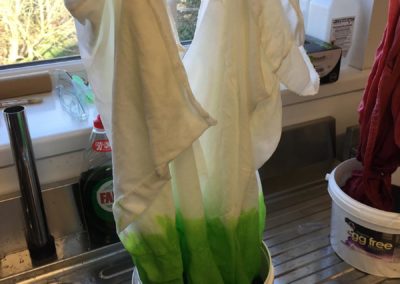 Did you know that when it comes to using modern dyes, animal based fibre and plant based fibre need different types of dye? The process of dyeing protein based fibre, ie wool, alpaca, cashmere and other animal fibres, requires the use of acid dyes and heat. The dyes themselves are not acid, but a small amount of white vinegar or citric acid is used to bond the dye permanently to the fibre.
Did you know that when it comes to using modern dyes, animal based fibre and plant based fibre need different types of dye? The process of dyeing protein based fibre, ie wool, alpaca, cashmere and other animal fibres, requires the use of acid dyes and heat. The dyes themselves are not acid, but a small amount of white vinegar or citric acid is used to bond the dye permanently to the fibre.
Plant derived fibres are cellulose based and include things like cotton, linen, ramie (a japanese nettle), and bamboo. They use a different type of dye that requires an alkaline fixer, usually soda ash. The dyes are known as fibre reactive and the clue is in the name – they react with the fibre and once the fixer is added, you can’t store them for long as they start to lose their potency.
Silk can be dyed with both types of dye, though it won’t always take up the colour in the same way as wool or cotton would, which can lead to some interesting results.
I am quite comfortable with acid dyes, but my experience with dyeing cellulose fibres is limited. I experimented recently with some cotton yarn and was pleased with my first two skeins – I used the same colours on both, just different proportions, so one has more blues, the other more greens.
I mentioned to my friend Linda (a felt artist who is no stranger to dyeing her own wool fibre) that I would be experimenting more with these fibre reactive dyes and before I knew it, I was heading home with a white linen top of hers that she had stopped wearing because, (to use her words), “It makes me look like a snowman!”.
She gave me carte blanche to use whatever colours I wanted, and I knew I wanted to echo Linda’s beautiful felted landscapes featuring the Mull of Galloway. I was a bit ambitious choosing to attempt a gradient on my first ever garment, but hey, let’s jump in at the deep end, why not!
Our garage has become my dye studio – it has an industrial catering sink with a hanging rail above it which was perfect for what I wanted to do. I hung the dress (upside down) from the hanging rail so I could dip it into the dye and control how much was immersed. The photos below show some of the process.
-

I started with the top of the dress sitting in a bucket of green dye.
-

Every 20 minutes or so, I would adjust the hanging clips, taking a little more of the fabric out of the bucket to get an ombre effect
-

The burnt orange is a linen tunic of my own which started out a natural beige colour.
-

I let the dress dry overnight before starting the bottom part.
-

Mixing the teal colour for the bottom part of the dress
-

OMG, look at that colour!
-

Now the top part of the dress is on hangers, being lowered into the dye bath
-

You need to keep stiring regularly if you don't want it to come out too patchy
-

A touch of magenta went in for the very bottom part of the dress
I mixed the colours myself starting with a vivid lime green, then a teal and finally just a touch of magenta, which took the teal into more of a navy-purple tone.
I’m absolutely thrilled with how this turned out and I think Linda’s pretty happy with it too. She’s definitely not going to look like a snowman in this!
Click on the images below for a better look. The last one shows how well it coordinates with one of my shawls. Linda is lucky this is too small for me or I would definitely have stolen it!
I dyed a linen dress of my own at the same time in a totally different colour, and it didn’t turn out so well. More on that in a future post as I have a plan to fix it, which may or may not work.
Meanwhile, here are a few of Linda’s gorgeous felted images which inspired this colourway. You can see more of her work on her Facebook Page.









That’s stunning Glenda! xxx
Thanks Carol, I’m going to have to make myself one now!
Fantastic and thank you so much for the wonderful garment! Summer here we come and no more snowman impersonations!!!
You’re welcome my friend, can’t wait to see you flouncing around in it!
Well done, it is really great. Love the colours.
Thanks Margaret, keeping my eyes peeled for a similar white top I can dye for myself now. x